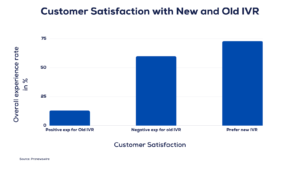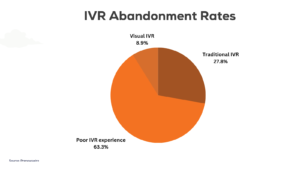Tech
How Visual IVR Can Improve the Customer Experience and Reduce Costs for Businesses?

Today’s call center industry that we know of is changing, thanks to a new technology called Visual IVR. It helps customers do things themselves and it’s definitely not like the old IVR systems we used for a long time. It is much easier to use and fixes many problems from the old system. More businesses started using Visual IVR now. It’s important to know how it differs from the old IVR.
One significant aspect is that Visual IVR employs pictures and menus on the web and phones, not just speech. This makes it easier to get help and avoids the annoying back-and-forth of the old system. It provides a better way for customers to receive assistance and enjoy a positive experience.
Indeed, Visual IVR does make our lives easier and swiftly resolve our problems. But what about the business? What impact does the IVR have on the business? The answer is, obviously the better ROI and reduced operating costs. Let us take a closer look at how IVR helps businesses.
Problems with Old IVR Systems
The old IVR systems have clear problems in today’s customer service. They make callers frustrated with confusing voice menus, which leads to longer waiting times and hearing the same things repeatedly. Studies show that most customers, around 60%, find these old IVR systems to give bad experiences, while only 13% think they’re good.
These systems struggle to answer difficult questions well, which makes customers upset. Language issues also make things harder. People with disabilities face trouble because there aren’t any pictures or visuals to help.
The old IVR can’t change to fit customers’ needs, so it feels distant. However, new innovations like visual IVR technology solve these issues. These systems feature straightforward screens that not only please customers but also provide swift assistance.
To know more about the study mentioned above, here is the bar chart that explains customer satisfaction with IVR.
Improving the IVR Experience through Visual Interfaces
Improving the IVR with pictures is a big improvement. Instead of only using voice, this new concept has menus on websites and phones. This change makes things work better and solves the annoying issues from the old IVR. Visual IVR is a strong method for customers to help themselves. It solves old problems and makes things simpler.
Many people are starting to like this idea, and it’s changing how call centers operate. The special thing about Visual IVR is that customers really enjoy it. It’s making support better and impressing customers with how effective it can be.
Connecting Callers to Live Agents with Visual IVR
Visual IVR can collaborate with chatbots and a company’s website contact pages. This lets customers easily switch between helping themselves and talking to a real person. It ensures that customers always get the help they need.
To make things even better for customers, there’s something called callbacks. This means customers don’t need to wait in line for a long time. They can leave their number and receive a call when an agent is available to converse.
Key Benefits of Visual IVR for Businesses
Visual IVR offers advantages beyond just making customers happy. It can also help businesses in many ways.
Initially, Visual IVR allows customers to select their preferred mode of communication, such as chat, email, text, or a callback.
Also, the pictures and menus help to get important information about what we as a customer want. And thus, take that information, and queries and cluster it in the form of groups. Easy questions go to the chatbots and important questions to call agents.
This significantly reduces the workload for call agents, enabling them to concentrate on more complex queries.
Most importantly, Visual IVR helps companies give great service. Good interactions with customers are really important in a busy market.
Cost Efficiency: How Visual IVR and Voice Call-Backs Reduce Cost-Per-Call
Looking beyond the immediate benefits, there is a compelling financial incentive for adopting Visual IVR. It can save businesses a lot of money, especially when you consider that the problems with old IVR systems cost companies $262 per customer every year.
- First, Visual IVR stops people from hanging up, making customers happier and saving money.
- Also, the eMoreover, the user-friendly screens expedite calls, allowing agents to assist a larger number of individuals.asy-to-understand screens make calls faster, which lets agents help more people.
- Visual IVR is good at sending customers to the right place, so companies spend less on phone calls.
- To gain a better understanding of the broader perspective, presented below is a pie chart illustrating the efficiency of the new Visual IVR system.
Best Practices for Enhancing Visual IVR
While saving money is a clear advantage of Visual IVR, its real power comes from making things better. To get the most out of it, businesses need to follow some important steps.
- Create a unique Visual IVR that’s not just like the old system. It should match the brand and give customers personalized help.
- Make sure it’s easy to use and works for everyone. Asking the right questions is important to send customers to the right place.
- Let customers use Visual IVR how they want. Don’t force them to call if they don’t want to. Things like callbacks can make it even easier.
- Finally, like any digital tool, keep testing and improving based on what customers say. Doing these things helps get the most value from Visual IVR.
The Synergy of Call-Backs and Visual IVR
Visual IVR and call-backs, when used together, create a powerful impact on customer interactions. Call-backs remove the frustration of waiting on hold, allowing customers to choose when an agent calls them back.
At the same time, Visual IVR offers an easy interface while customers wait for the scheduled call-back. They can find more information or explore other services. This combo makes customers feel better about the brand.
When used together, call-backs and Visual IVR can really make customers happier, reduce hang-ups, and solve issues faster. This combination can alter customers’ sentiments and result in cost savings for contact centers.
The Future with Visual IVR
As we’ve seen in this evolution, visual IVR is not just a short-lived trend. It’s a big change that can really affect how customers interact.
Using Visual IVR with things like callbacks can help brands build strong connections with customers and work more smoothly. Right now is the time for companies to think about new ways of doing things and to stay competitive in the digital age. A revolution in customer treatment is currently underway.
Frequently Asked Questions (FAQs)
1. How does Visual IVR differ from traditional IVR systems?
Visual IVR offers online customers a web menu or digital mobile interface, replacing voice prompts with visual cues.
2. Can businesses customize the appearance and functionality of Visual IVR to align with their brand?
Yes, Visual IVR systems like Fonolo’s Web Call-Backs can be tailored both visually and functionally to suit specific business needs.
3. How do call-backs enhance the Visual IVR experience for customers?
Callbacks allow customers to skip long hold times and receive a call-back from an available agent, leading to higher satisfaction and efficient interactions.
-
Blog1 year ago
MyCSULB: Login to CSULB Student and Employee Portal – MyCSULB 2023
-
Android App3 years ago
Cqatest App What is It
-
Android1 year ago
What Is content://com.android.browser.home/ All About in 2023? Set Up content com android browser home
-
Software2 years ago
A Guide For Better Cybersecurity & Data Protection For Your Devices
-
Latest News2 years ago
Soap2day Similar Sites And Alternatives To Watch Free Movies
-
Android2 years ago
What is OMACP And How To Remove It? Easy Guide OMACP 2022
-
Android3 years ago
What is org.codeaurora.snapcam?
-
Business2 years ago
Know Your Business (KYB) Process – Critical Component For Partnerships























